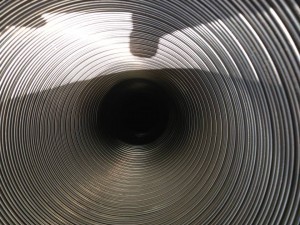 When you light up your fireplace, you can sit back and enjoy the warmth knowing that all the gas and smoke being created that could otherwise be harmful to your home are drifting safely up and out through your chimney. If something is wrong with your chimney flue though, you may not get this experience the way you expect.
When you light up your fireplace, you can sit back and enjoy the warmth knowing that all the gas and smoke being created that could otherwise be harmful to your home are drifting safely up and out through your chimney. If something is wrong with your chimney flue though, you may not get this experience the way you expect.
For many people, it may come as a surprise that your chimney isn’t just the brick chute you see from the outside. Instead, the brick and mortar act as a visually pleasing cover over the part that is really responsible for getting rid of all that smoke: your chimney flue.
Your flue is quite important to the operation of your fireplace so it is a good idea to brush up on your understanding of this structure so you can be prepared when the time comes for repairs.
What is a Chimney Flue?
Let’s start with the first question almost everyone has: what is a chimney flue? While the term flue used to just refer to the chimney itself, today, the flue is a clay, ceramic or metal tube inserted within the interior of your chimney that removes the smoke and gas created by your fireplace.
Why Do I Need a Chimney Flue?
Even if you have a chimney, you need a flue inside of it. This is because the flue serves to protect both you and your chimney in the following ways:
- It protects the home from heat transfer: Your flue stops heat from moving through the chimney too rapidly which would otherwise create a big fire risk.
- It protects the masonry from corrosion: Your flue stops gases from penetrating into the brick and mortar of your chimney. These gases have the potential to break down the mortar joints in your chimney, creating serious risks to your home.
- It provides efficiency: A flue that is correctly sized will allow the by-products of combustion to pass out of the home whereas an incorrectly sized liner can create creosote build-up that presents a fire risk.
When Your Flue Needs Service
Your chimney flue or chimney liner is going to need upkeep much like any other part of your home comfort system. The question is, how do you know when the time has come for service? Here are a few signs to watch for:
- A smokey room: If your liner is too small, smoke and gas can’t properly escape and may instead come into the house.
- Finding pieces of the liner: If you have a clay liner and are finding pieces of it in your fireplace, your liner needs repair.
- Finding creosote build-up: During a chimney inspection if your technician finds excessive creosote buildup in the chimney it may be due to cracks or leaks in the liner.
If you are looking for chimney liner repairs in St. Paul, you can trust the team at 2nd Generation Chimneys, Inc. to help.
Contact the professional technicians at 2nd Generation Chimneys today to schedule your next repair service.
